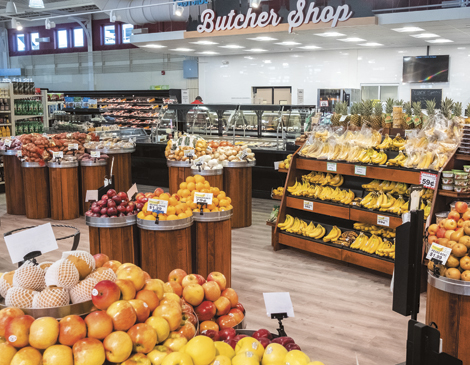Fresh leafy greens, stalks of asparagus and freshly made lasagna fill the shelves of the newly reopened East Side Market. A pretty typical scene in many cities is revelatory here in Glenville. Since the market closed in 2007, the neighborhood has been a food desert, an area where at least 33 percent of residents are more than a mile away from a grocery store. Northeast Ohio Neighborhood Health Services spearheaded a $7 million project that reopened the grocery store in February. It hopes to use the facility as a community center, health clinic and demonstration kitchen. “This is providing something different, something needed,” says manager Jennifer Lang. “We are providing something no one else in the neighborhood can.” Here are four things to know about the new source for whole foods.
Feeling Green
Greens, asparagus and prepared foods such as meatloaf and lasagna are some of shoppers’ favorite items, Lang says. Previously, many residents, especially those with disabilities or the elderly, had to shop at nearby dollar or convenient stores, which lacked fresh produce. “We want to flip the switch on people’s diets,” Lang says. Local activists hope this is the first step in a discussion of how to serve the more than 400,000 Cuyahoga County residents currently living in food deserts.
The original East Side Market opened in 1988. At its peak, it provided space for 25 merchants. But poverty and population decline forced it to close in 2007. In 2015, Northeast Ohio Neighborhood Health Services leased the site with the city providing a 75-percent, 15-year tax abatement on any improvements made to the property. The hope is that the new market is a source of stimulation for the local economy.
Slow Roll
While the grocery store is open, full services such as a clinic and test kitchen are set to launch May 23. With the goal of teaching residents simple, healthy recipes with food that they can purchase at the market, cooking demonstrations are the feature customers seem most excited about, says Lang. “Everyone asks when the test kitchen is going to open,” she says. “It’s amazing how far one healthy recipe can go.”
Labor Crunch
In an area starved for good gigs, the grocery store offers 25 full-time positions. These jobs will generate an estimated $520,000 in annual wages that will get funneled back into the local economy. Currently, 85 percent of the market’s staff are neighborhood residents. This also benefits customers, who enjoy recognizing the faces helping them pick the freshest vegetables or pre-made items from the deli. “Knowing people here makes shopping here comfortable,” Lang says.




